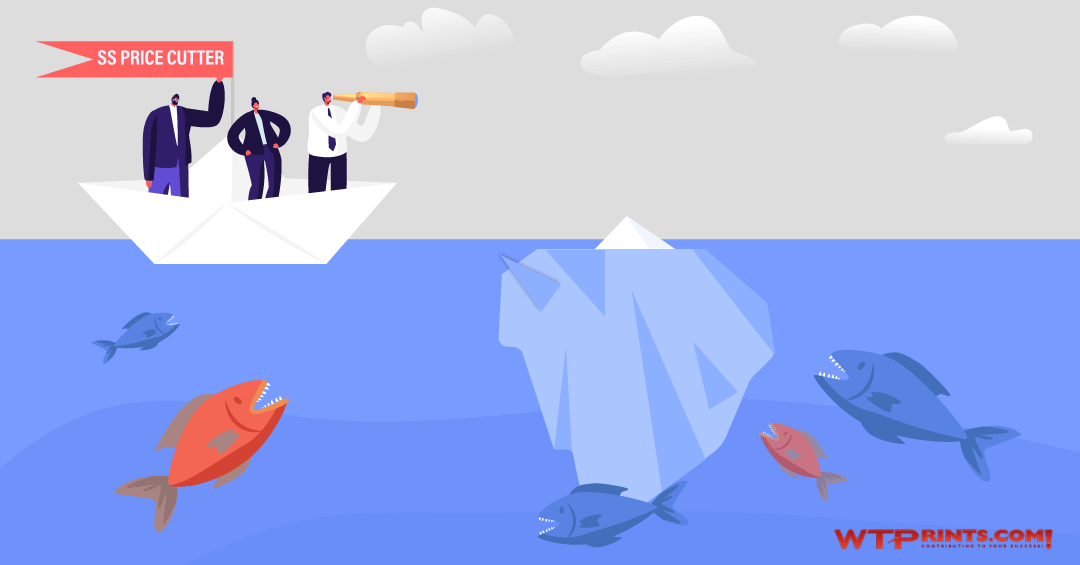Print buyers are most efficient when they operate in a “low overhead” manner.
They get maximum print output and revenue for time, money and resources invested.
A low overhead print buyer operates with two or three trusted providers such as WTP and ColorFX, for example. They check with their providers to get quotes and orders placed in minutes, or to quickly get the status of a job in production.
You’ll notice I did not say they are most efficient because they get the lowest prices from vendors.
‘Low price’ buying can limit efficiency and net profit.
Allow me to explain the hard dollars-and-cents reasons why.
What Is ‘Low Overhead’ Print Buying?
I confess, I've spent hours shopping to save maybe 50.00... then it's like …why??
Now I have 4 items to track coming from 4 locations at 4 different times.
Come on, admit it, you've done it at least once.
It’s the heart of why so much of the world continues to shop on Amazon. Consumers don’t always get the best price. But they do save time. They get “free” overnight or 2-day shipping. They can track shipments and if necessary, return them, all in one place. And they shop conveniently from home or wherever they are.
Think about all the other important providers in our lives.
What about vehicle maintenance? One or two trusted providers right? We don’t shop around every time we need to change the oil.
Home repairs and improvements? I'll get three or four bids and most likely toss out the highest and lowest bid with very little scrutiny. Then I’ll choose from the bids in the middle.
Office supplies? Do you shop one vendor for pens and pencils, another for paper clips, a third for staples? Probably not, even though there are vendors that could likely save five or ten percent, or more, on certain items.
Appliances?
You see it too right?
Print buying should be no different. Yet it often is, with buyers shopping every job, every time, even on business cards.
Some buyers argue, “Well, those nickels and dimes add up over the course of a year.”
I maintain that the hidden expenses of continuous price shopping far outweigh the nickels and dimes they claim to be saving.
4 Hidden Costs (and Dangers) of Price Shopping in Print Buying

1 - Time.
To be effective, it’s important for every owner to assign a dollar value to their time. Just like they do for employees.
For example, if an owner values their time at $200/hour, they likely won’t spend an hour trying to save 10 or 20 bucks.
Now, they might delegate the shopping task to staff. Yet that raises even more questions and costly problems.
Let’s face it. Employees create work.
If their job is to shop, they prove their professional worth by doing the most shopping. Is that what you want? Is it adding value?
2 - Misalignment of Values
Is your business successful because you always have the lowest prices? Highest prices? Or is it successful because you provide the greatest value?
If the latter, why in the world would you align your business with suppliers that do not provide to you that which you provide to your customers? After all, lowest price does not equal greatest value.
Such misalignment shows up in several ways.
3 - Operational Chaos
Price-buying creates a chaotic, risk-prone environment at the buyer’s company. With dozens of vendors, timelines, points of contact, and logistics providers, it’s a lot to manage. Every extra item is one more opportunity for something to go wrong.
Every job that gets reprinted due to a mistake costs a lot. There are the reprint costs. PLUS re-shipping. PLUS lost opportunity (they should be printing another profitable job.) PLUS the potential loss of a client. This can add up to tens or hundreds of thousands of dollars.
The fact is that companies that minimize risks run better and make more profit.
And as I mentioned, an employee whose job is to manage a lot of vendors will justify their worth by finding more to manage. Productivity and profit takes a back seat.
4 - Emotional Turmoil
A chaotic environment takes an emotional toll on employees. You’ll see burnout and high turnover at companies that operate this way.
The Society for Human Resource Management found that it costs an average of 6 to 9 month’s salary to replace an employee. That means a $50,000 employee costs $25,000 to $37,500 to replace. It takes a lot of nickels and dimes to cover that cost!
More Benefits of ‘Low Overhead’ Print Buying
Working with efficient trade printing providers such as WTP eliminates those hidden, damaging costs of price-shopping.
Good ‘low overhead’ print providers offer:
- Accurate and consistent color using G7 methodology and Gracol standards.
- A live person to take your call or get back to you right away.
- Timely responses to emails and voicemails.
- Timely delivery with trusted logistics providers.
- Pricing that allows for healthy client profit margins.
- Experienced, professional staff. Here at WTP we have 250+ combined years of print experience.
To sum it up…I’ll make the bold claim that companies that move from a ‘lowest price’ print buying model to a ‘low overhead’ model will make themselves more profitable.
Efficient low-overhead wholesale print providers like WTP deliver the greatest value to your clients and healthy profit margins for your bottom line.
Let us know what we can do to improve your print buying process. Call me direct at 559-251-8595 ext. 411.
Get More Tips and Articles for Quick and Commercial Printers